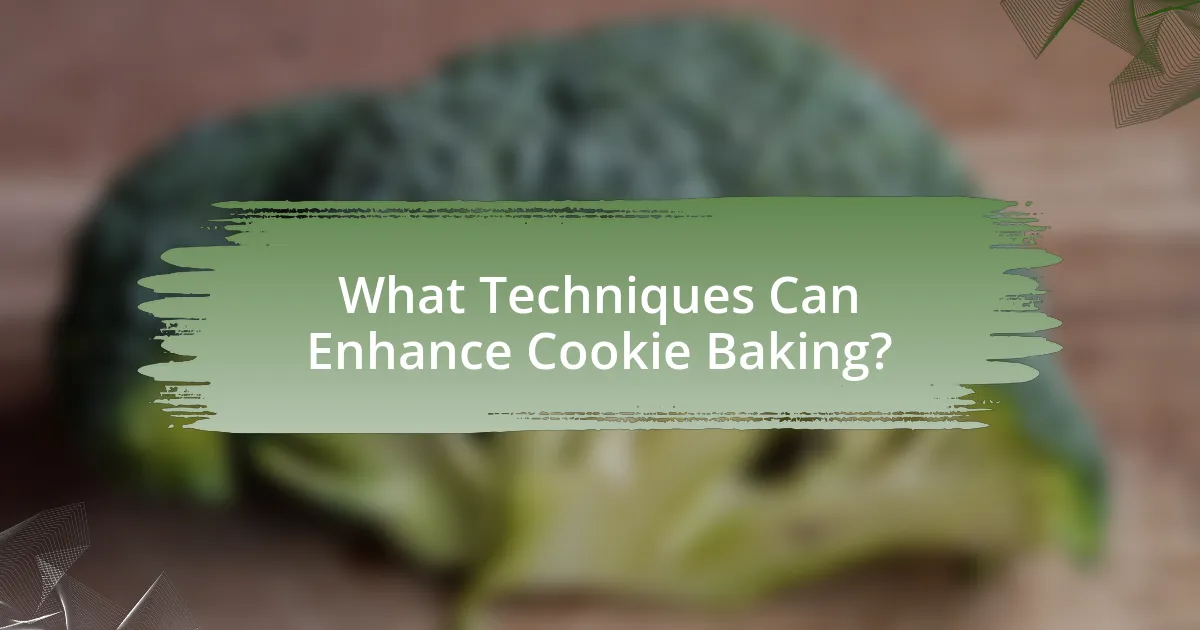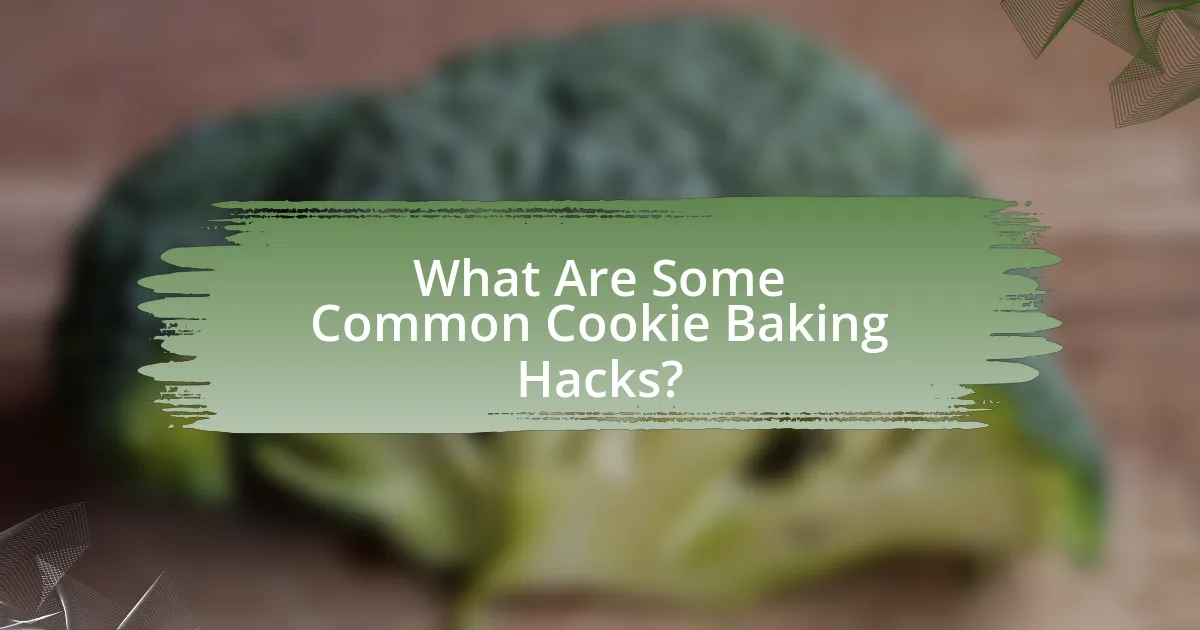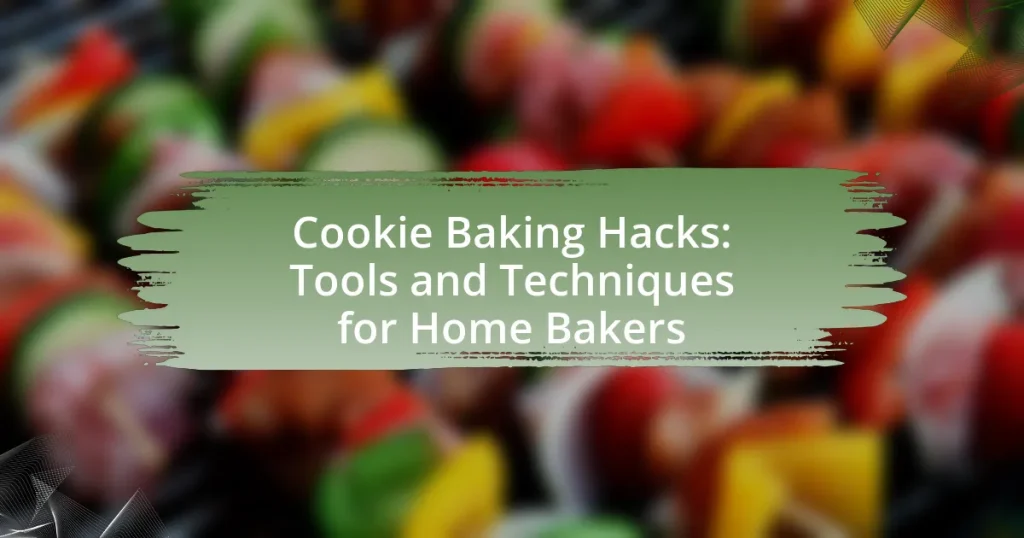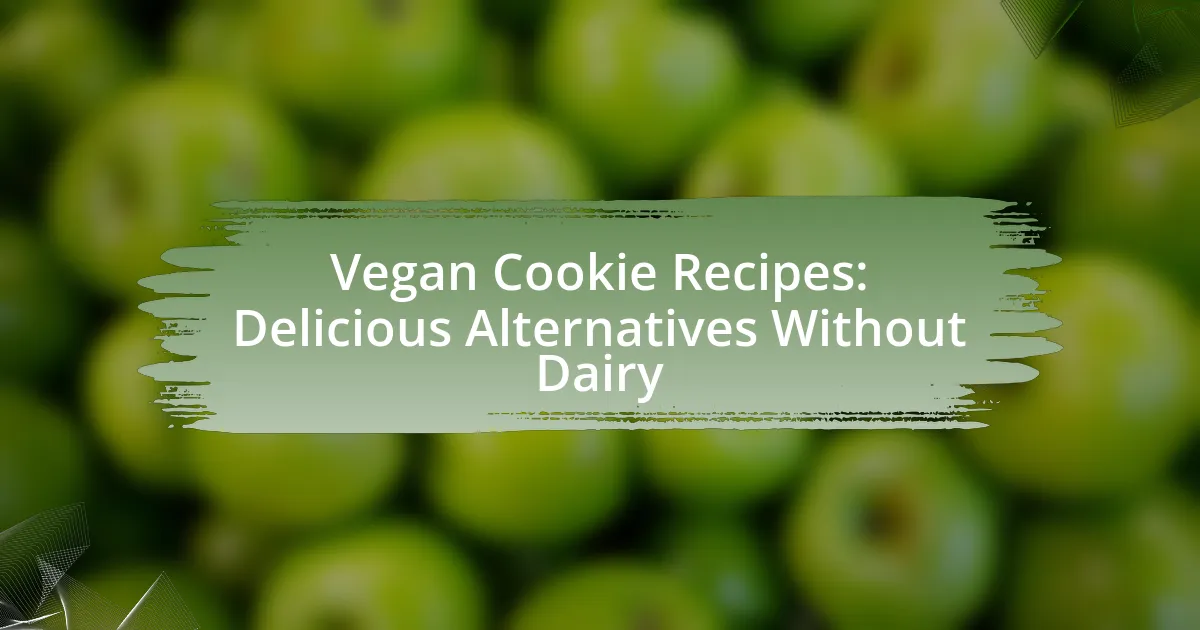Cookie baking hacks encompass practical tips and techniques designed to enhance the baking process, improve cookie texture, and ensure consistent results. Key strategies include chilling dough to prevent spreading, using parchment paper for even baking, and employing precise measuring tools to address common challenges faced by home bakers. The article explores how these hacks can elevate the final product by improving flavor, texture, and presentation, while also emphasizing the importance of ingredient preparation and baking methods. Additionally, it provides troubleshooting tips for common baking issues and highlights essential tools that every home baker should have to achieve optimal results.

What are Cookie Baking Hacks?
Cookie baking hacks are practical tips and techniques that enhance the baking process, improve cookie texture, and ensure consistent results. For example, chilling cookie dough before baking can prevent spreading, resulting in thicker cookies. Additionally, using parchment paper on baking sheets promotes even baking and easy cleanup. These hacks are supported by baking science, which shows that temperature control and proper materials significantly affect the final product.
How can cookie baking hacks improve your baking experience?
Cookie baking hacks can significantly enhance your baking experience by streamlining processes and improving the quality of the final product. For instance, using chilled dough can prevent cookies from spreading too much during baking, resulting in thicker, chewier cookies. Additionally, incorporating techniques such as using parchment paper for baking can facilitate easier cleanup and prevent sticking, which is supported by the fact that many professional bakers recommend this method for consistent results. These hacks not only save time but also lead to more enjoyable and successful baking outcomes.
What specific challenges do home bakers face that hacks can address?
Home bakers face challenges such as inconsistent baking results, ingredient measurement inaccuracies, and time management issues. Inconsistent baking results can stem from variations in oven temperature and baking times, which hacks like using an oven thermometer and pre-measuring ingredients can help mitigate. Ingredient measurement inaccuracies often lead to failed recipes; hacks such as using a kitchen scale for precise measurements can address this issue effectively. Time management challenges arise from the need to multitask during baking; hacks like preparing dough in advance or using time-saving tools, such as food processors, can streamline the process and improve efficiency.
How do these hacks enhance the final product?
These hacks enhance the final product by improving texture, flavor, and presentation of cookies. For instance, techniques such as chilling the dough can prevent spreading, resulting in thicker cookies, while using brown sugar instead of white sugar can enhance moisture and flavor depth. Additionally, incorporating tools like silicone baking mats can ensure even baking and prevent sticking, leading to a more visually appealing final product. Studies show that specific ingredient ratios and baking methods significantly impact the sensory qualities of baked goods, confirming that these hacks are effective in elevating cookie quality.
Why are tools important in cookie baking?
Tools are important in cookie baking because they ensure precision, consistency, and efficiency in the baking process. For instance, measuring cups and spoons allow bakers to accurately measure ingredients, which is crucial since even slight variations can affect the texture and flavor of cookies. Additionally, tools like mixers and spatulas facilitate the thorough mixing of ingredients, promoting even distribution of flavors and textures. Research indicates that using the right tools can reduce baking time and improve the overall quality of baked goods, as proper equipment helps maintain optimal temperatures and mixing techniques.
What essential tools should every home baker have?
Every home baker should have essential tools including measuring cups, mixing bowls, a whisk, a rolling pin, baking sheets, and an oven thermometer. Measuring cups ensure accurate ingredient quantities, which is crucial for baking success. Mixing bowls facilitate the combining of ingredients, while a whisk is vital for incorporating air into mixtures. A rolling pin is necessary for flattening dough, and baking sheets provide a surface for cookies to bake evenly. An oven thermometer is important for verifying that the oven temperature is accurate, as even slight deviations can affect baking results. These tools collectively enhance the baking process and improve the quality of baked goods.
How do specialized tools affect the baking process?
Specialized tools significantly enhance the baking process by improving precision, consistency, and efficiency. For instance, tools like digital scales ensure accurate measurements of ingredients, which is crucial for achieving the desired texture and flavor in cookies. Additionally, silicone baking mats provide even heat distribution and prevent sticking, leading to better baking results. Research indicates that using specialized equipment, such as temperature-controlled ovens, can reduce baking time and improve the overall quality of baked goods, as they maintain optimal conditions for various recipes.

What Techniques Can Enhance Cookie Baking?
Techniques that can enhance cookie baking include using chilled dough, measuring ingredients accurately, and incorporating baking soda or baking powder for leavening. Chilling the dough allows the fats to solidify, resulting in thicker cookies that maintain their shape during baking. Accurate measurement of ingredients ensures the right balance of flavors and textures; for instance, too much flour can lead to dry cookies. Additionally, using baking soda or baking powder helps cookies rise and achieve a desirable texture. These techniques are supported by baking science, which emphasizes the importance of temperature and ingredient ratios in achieving optimal results.
How does ingredient preparation impact cookie baking?
Ingredient preparation significantly impacts cookie baking by influencing texture, flavor, and overall consistency. For instance, using room temperature butter instead of cold butter allows for better incorporation of air, resulting in a lighter cookie. Additionally, properly measuring flour using the spoon-and-level method prevents excess flour, which can lead to dry cookies. Research indicates that ingredient ratios and preparation methods directly affect the Maillard reaction, which is crucial for browning and flavor development in baked goods. Therefore, meticulous ingredient preparation is essential for achieving the desired cookie characteristics.
What are the best practices for measuring ingredients?
The best practices for measuring ingredients include using precise tools, such as digital scales for weight measurements and liquid measuring cups for volume. Accurate measurement is crucial in baking, as it affects the texture and flavor of cookies. For dry ingredients, spoon them into measuring cups and level off with a straight edge to avoid packing, which can lead to excess amounts. When measuring flour, for instance, the difference between scooping directly from the bag and spooning it into a cup can be significant, potentially altering the final product. Additionally, for sticky ingredients like honey or molasses, lightly greasing the measuring cup can help ensure complete transfer. These practices are supported by baking science, which emphasizes the importance of ingredient ratios for achieving desired results in baked goods.
How does the temperature of ingredients affect the dough?
The temperature of ingredients significantly affects the dough’s texture and consistency. When ingredients like butter and eggs are at room temperature, they blend more easily, creating a smoother dough that incorporates air, leading to a lighter and fluffier final product. Conversely, using cold ingredients can result in a denser dough, as the fats do not emulsify properly, inhibiting the incorporation of air. Research indicates that for optimal cookie texture, butter should be softened to around 65°F (18°C) to achieve the desired spread and chewiness.
What baking methods can improve cookie texture and flavor?
To improve cookie texture and flavor, methods such as chilling the dough, using different sugars, and adjusting baking times can be effective. Chilling the dough for at least 30 minutes allows the fats to solidify, resulting in a thicker cookie with a chewier texture. Utilizing a combination of brown sugar and granulated sugar enhances moisture and adds depth of flavor due to the molasses content in brown sugar. Additionally, baking cookies at a slightly lower temperature for a longer time can create a softer center while maintaining a crisp edge, as supported by baking science principles that emphasize the Maillard reaction and caramelization for flavor development.
How does the mixing technique influence cookie outcomes?
The mixing technique significantly influences cookie outcomes by affecting the texture, spread, and overall structure of the cookies. For instance, creaming butter and sugar together incorporates air, leading to a lighter and fluffier texture, while over-mixing can result in tough cookies due to gluten development. Additionally, the method of mixing, such as folding versus stirring, impacts how ingredients combine, which can alter the final product’s density and moisture content. Research indicates that the mixing time and technique directly correlate with the cookie’s final characteristics, such as chewiness or crispness, demonstrating the importance of proper mixing in achieving desired cookie results.
What role does baking time and temperature play in cookie quality?
Baking time and temperature are critical factors that directly influence cookie quality. The correct baking time ensures that cookies achieve the desired texture, whether chewy or crispy, while the appropriate temperature affects the spread and color of the cookies. For instance, baking cookies at a higher temperature for a shorter time can result in a crisp exterior and soft interior, while lower temperatures may lead to a more uniform texture but can also cause cookies to spread too much. Research indicates that cookies baked at 350°F for 10-12 minutes typically yield optimal results, balancing browning and texture. Thus, precise control over baking time and temperature is essential for achieving the ideal cookie quality.

What Are Some Common Cookie Baking Hacks?
Some common cookie baking hacks include chilling the dough to prevent spreading, using parchment paper for easy removal, and adding a pinch of salt to enhance flavor. Chilling the dough for at least 30 minutes solidifies the fat, resulting in thicker cookies. Parchment paper creates a non-stick surface, making it easier to transfer cookies without breaking. Additionally, incorporating a small amount of salt balances sweetness and intensifies the overall flavor profile, as supported by culinary experts who emphasize the importance of salt in baking.
How can you achieve the perfect cookie shape and size?
To achieve the perfect cookie shape and size, use a cookie scoop for uniform portions and chill the dough before baking. A cookie scoop ensures that each cookie is the same size, promoting even baking and consistent shape. Chilling the dough solidifies the fat, preventing excessive spreading during baking, which helps maintain the desired shape. Studies show that chilling cookie dough can reduce spread by up to 50%, resulting in thicker cookies with defined edges.
What hacks can help with cookie portioning and shaping?
Using a cookie scoop is an effective hack for portioning and shaping cookies consistently. A cookie scoop allows bakers to measure out uniform amounts of dough, ensuring even baking and consistent size. Additionally, chilling the dough before shaping helps prevent stickiness, making it easier to form perfect rounds. For added precision, bakers can use a kitchen scale to weigh each portion, achieving exact measurements. These methods are supported by baking experts who emphasize the importance of uniformity in cookie size for optimal baking results.
How can you ensure even baking for all cookies?
To ensure even baking for all cookies, use an oven thermometer to verify accurate temperature and rotate the baking sheet halfway through the baking time. An oven thermometer provides precise temperature readings, which is crucial since many ovens can be off by as much as 25 degrees Fahrenheit. Rotating the baking sheet helps to counteract hot spots in the oven, promoting uniform heat distribution. Additionally, spacing cookies adequately on the baking sheet allows for proper air circulation, further contributing to even baking.
What are some creative flavor enhancements for cookies?
Some creative flavor enhancements for cookies include adding spices like cinnamon or cardamom, incorporating citrus zest such as lemon or orange, and using extracts like almond or coconut. These enhancements can elevate the flavor profile of cookies significantly. For instance, cinnamon can add warmth and depth, while citrus zest introduces a refreshing brightness. Additionally, using high-quality extracts can provide a more intense flavor compared to standard vanilla. According to a study published in the Journal of Food Science, the addition of spices and extracts can enhance the sensory attributes of baked goods, making them more appealing to consumers.
How can you incorporate unique ingredients into your cookie recipes?
To incorporate unique ingredients into cookie recipes, start by selecting unconventional elements such as spices, herbs, or alternative flours. For example, adding cardamom or rosemary can enhance flavor profiles, while using almond flour or coconut flour can alter texture and nutritional content. Research indicates that incorporating unique ingredients not only diversifies taste but also caters to dietary preferences, as seen in gluten-free baking trends. By experimenting with these ingredients, bakers can create distinctive cookies that stand out in flavor and appeal.
What are some tips for balancing flavors in cookies?
To balance flavors in cookies, use a combination of sweet, salty, and acidic ingredients. Sweetness can be adjusted by varying the amount of sugar or incorporating ingredients like honey or maple syrup, while salt enhances sweetness and balances flavors. Adding a touch of acidity, such as lemon juice or vinegar, can brighten the overall taste. For example, using dark chocolate chips instead of semi-sweet can introduce a richer flavor profile, while incorporating nuts can add texture and a savory element. These adjustments create a more complex and satisfying flavor experience in cookies.
What troubleshooting tips can help with common baking issues?
To address common baking issues, ensure accurate measurements, as incorrect ratios can lead to undesirable textures. For instance, too much flour can result in dry cookies, while too little can cause spreading. Additionally, check oven temperature with an oven thermometer; an inaccurate temperature can lead to underbaking or overbaking. If cookies spread too much, refrigerate the dough before baking to firm it up. For cookies that are too hard, consider reducing baking time or adding moisture through ingredients like brown sugar or an extra egg yolk. These tips are supported by baking science, which emphasizes the importance of precise measurements and temperature control in achieving desired results.
How can you fix cookies that spread too much?
To fix cookies that spread too much, reduce the amount of butter or increase the flour in the recipe. Excess butter can cause cookies to spread excessively during baking, while adding more flour helps to create a thicker dough that holds its shape. Additionally, chilling the dough for at least 30 minutes before baking can also help prevent spreading, as it solidifies the fats and allows for better structure during baking. These adjustments are supported by baking science, which indicates that the balance of fat and flour is crucial for cookie texture and shape.
What should you do if cookies are too dry or crumbly?
To remedy dry or crumbly cookies, add moisture by incorporating a small amount of liquid, such as milk or water, into the dough. This adjustment helps to rehydrate the ingredients, improving the texture. Additionally, consider increasing the fat content by adding more butter or oil, as fats contribute to a softer cookie consistency. It is also beneficial to ensure that the flour measurement is accurate, as too much flour can lead to dryness; using a kitchen scale for precise measurements can prevent this issue.
What are the best practices for storing and freezing cookies?
The best practices for storing and freezing cookies include using airtight containers and proper wrapping techniques. Storing cookies in airtight containers prevents moisture loss and keeps them fresh for up to a week at room temperature. For longer storage, freezing cookies is effective; wrap each cookie individually in plastic wrap or aluminum foil, then place them in a freezer-safe bag or container. This method preserves texture and flavor for up to three months. When ready to eat, cookies can be thawed at room temperature or warmed in an oven, ensuring they retain their original quality.
How can proper storage extend the freshness of cookies?
Proper storage can extend the freshness of cookies by minimizing exposure to air and moisture, which are primary factors in staleness. When cookies are stored in airtight containers, they retain their moisture and texture, preventing them from becoming hard or dry. Research indicates that cookies stored in a cool, dark place can maintain their quality for up to two weeks, while refrigeration can extend freshness even further, although it may alter the texture. Additionally, using parchment paper or wax paper between layers of cookies can prevent them from sticking together, preserving their individual texture and flavor.
What techniques are effective for freezing cookies without compromising quality?
To effectively freeze cookies without compromising quality, it is essential to use proper wrapping and storage techniques. First, allow the cookies to cool completely before freezing to prevent moisture buildup. Next, wrap each cookie individually in plastic wrap or aluminum foil to protect against freezer burn. After wrapping, place the cookies in an airtight container or a resealable freezer bag, removing as much air as possible to maintain freshness. This method preserves the texture and flavor of the cookies, as studies indicate that proper packaging can significantly reduce moisture loss and freezer burn, which are common causes of quality degradation in frozen baked goods.
What are some final tips for successful cookie baking?
To achieve successful cookie baking, ensure precise measurements of ingredients, as accuracy directly impacts texture and flavor. Using a kitchen scale for dry ingredients and liquid measuring cups for wet ingredients can enhance consistency. Additionally, chilling the dough for at least 30 minutes before baking helps prevent spreading, resulting in thicker cookies. Baking on parchment paper promotes even heat distribution and easy removal. Finally, always preheat the oven to the correct temperature, as this is crucial for proper cookie rise and browning. These practices are supported by baking science, which emphasizes the importance of ingredient ratios and temperature control in achieving optimal results.
How can you experiment with cookie recipes while ensuring success?
To experiment with cookie recipes while ensuring success, start by making small adjustments to one ingredient at a time, such as sugar type or flour amount. This method allows you to isolate the effects of each change, making it easier to identify what works best. For instance, using brown sugar instead of white sugar can enhance moisture and flavor, while adjusting flour can affect texture. Additionally, keeping detailed notes on each variation helps track results and refine future experiments. This systematic approach is supported by baking science, which emphasizes the importance of ingredient ratios and their interactions in achieving desired outcomes.
What resources are available for home bakers looking to improve their skills?
Home bakers can improve their skills through various resources such as online courses, baking blogs, YouTube channels, and cookbooks. Online platforms like MasterClass and Skillshare offer structured courses taught by professional bakers, providing in-depth techniques and tips. Baking blogs, such as Sally’s Baking Addiction and Joy of Baking, feature detailed recipes and tutorials that cater to different skill levels. YouTube channels like Bigger Bolder Baking and Tasty provide visual demonstrations, making complex techniques easier to understand. Additionally, cookbooks by renowned bakers, such as “The Joy of Baking” by Stephanie Jaworski, offer comprehensive guidance and recipes that can enhance baking skills. These resources collectively provide a well-rounded approach for home bakers to refine their craft.




